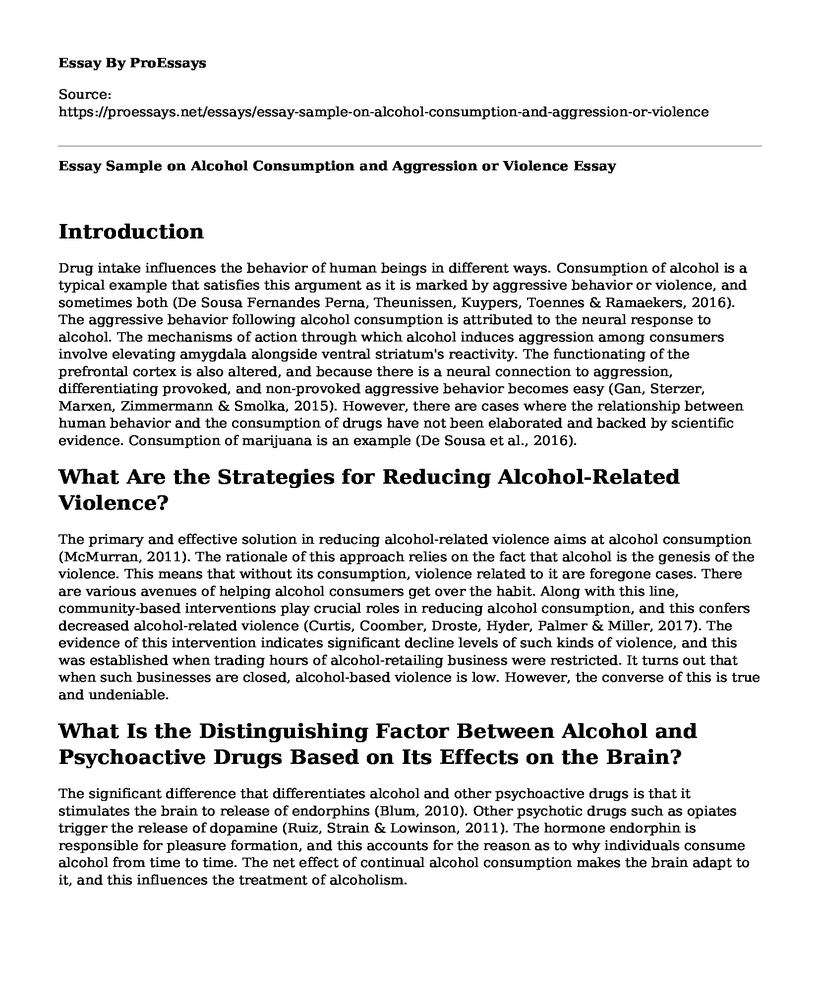Introduction
Drug intake influences the behavior of human beings in different ways. Consumption of alcohol is a typical example that satisfies this argument as it is marked by aggressive behavior or violence, and sometimes both (De Sousa Fernandes Perna, Theunissen, Kuypers, Toennes & Ramaekers, 2016). The aggressive behavior following alcohol consumption is attributed to the neural response to alcohol. The mechanisms of action through which alcohol induces aggression among consumers involve elevating amygdala alongside ventral striatum's reactivity. The functionating of the prefrontal cortex is also altered, and because there is a neural connection to aggression, differentiating provoked, and non-provoked aggressive behavior becomes easy (Gan, Sterzer, Marxen, Zimmermann & Smolka, 2015). However, there are cases where the relationship between human behavior and the consumption of drugs have not been elaborated and backed by scientific evidence. Consumption of marijuana is an example (De Sousa et al., 2016).
What Are the Strategies for Reducing Alcohol-Related Violence?
The primary and effective solution in reducing alcohol-related violence aims at alcohol consumption (McMurran, 2011). The rationale of this approach relies on the fact that alcohol is the genesis of the violence. This means that without its consumption, violence related to it are foregone cases. There are various avenues of helping alcohol consumers get over the habit. Along with this line, community-based interventions play crucial roles in reducing alcohol consumption, and this confers decreased alcohol-related violence (Curtis, Coomber, Droste, Hyder, Palmer & Miller, 2017). The evidence of this intervention indicates significant decline levels of such kinds of violence, and this was established when trading hours of alcohol-retailing business were restricted. It turns out that when such businesses are closed, alcohol-based violence is low. However, the converse of this is true and undeniable.
What Is the Distinguishing Factor Between Alcohol and Psychoactive Drugs Based on Its Effects on the Brain?
The significant difference that differentiates alcohol and other psychoactive drugs is that it stimulates the brain to release of endorphins (Blum, 2010). Other psychotic drugs such as opiates trigger the release of dopamine (Ruiz, Strain & Lowinson, 2011). The hormone endorphin is responsible for pleasure formation, and this accounts for the reason as to why individuals consume alcohol from time to time. The net effect of continual alcohol consumption makes the brain adapt to it, and this influences the treatment of alcoholism.
Why Treating Alcoholism Is a Nightmare
Alcohol treatment is a nightmare because of the physiological changes that come with its consumptions. Alcohol consumption triggers endorphin release, and if it continues for long, the brain adapts to the release of endorphins. However, the most devastating brain effect of alcohol that affects the treatment process of alcoholism is the fact that it triggers irreversible damage to the brain cells (Scherer, 2013). When the brain cells are irreversibly damaged, they are good as dead (Battersby, 2016). Because they are dead, the body cannot respond to any form of therapy targeting them. This is because they are unresponsive.
Conclusion
Consumption of drugs potentiates behavioral changes in human beings. Alcohol is an excellent example of a drug that confers aggression or violence among users. In effort to eradicate abuse of drugs, it became clear that violence incidences emanating from alcohol consumption significantly reduced when the alcohol-retailing business enterprise was closed. Alcohol manifests and initiates most of its side effects from the brain. Continual consumption of alcohol damages the brain irreversibly, and this accounts for the reason as to why treating alcoholism is a nightmare.
References
Battersby, S. (2016). Clay's Handbook of Environmental Health. London, England: Routledge. Retrieved from https://books.google.co.ke/books?id=VW94AgAAQBAJ&pg=PA184&dq=what+happens+when+brain+cells+are+irreversibly+damaged?&hl=en&sa=X&ved=0ahUKEwjP-fyJpM3gAhUD2eAKHRkHBBIQ6AEILjAB#v=onepage&q=what%20happens%20when%20brain%20cells%20are%20irreversibly%20damaged%3F&f=false
Blum, K. (2010). Alcohol and the addictive brain. Simon and Schuster. Retrieved from https://books.google.co.ke/books?id=111OrqcN0zYC&pg=PA187&dq=alcohol+and+the+release+of+endorphins&hl=en&sa=X&ved=0ahUKEwjnxYSGnc3gAhXCAWMBHY3JAlsQ6AEIKDAA#v=onepage&q=alcohol%20and%20the%20release%20of%20endorphins&f=false
Curtis, A., Coomber, K., Droste, N., Hyder, S., Palmer, D., & Miller, P. G. (2017). The effectiveness of community-based interventions for reducing alcohol-related harm in two metropolitan and two regional sites in Victoria, Australia. Drug and Alcohol Review, 36(3), 359-368. doi:10.1111/dar.12501
De Sousa Fernandes Perna, E. B., Theunissen, E. L., Kuypers, K. P., Toennes, S. W., & Ramaekers, J. G. (2016). Subjective aggression during alcohol and cannabis intoxication before and after aggression exposure. Psychopharmacology, 233(18), 3331-3340. doi:10.1007/s00213-016-4371-1
Gan, G., Sterzer, P., Marxen, M., Zimmermann, U. S., & Smolka, M. N. (2015). Neural and Behavioral Correlates of Alcohol-Induced Aggression Under Provocation. Neuropsychopharmacology, 40(13), 2886-2896. doi:10.1038/npp.2015.141
McMurran, M. (2011). Individual-level interventions for alcohol-related violence: A rapid evidence assessment. Criminal Behaviour and Mental Health, 22(1), 14-28. doi:10.1002/cbm.821
Ruiz, P., Strain, E. C., & Lowinson, J. H. (2011). Lowinson and Ruiz's substance abuse: A comprehensive textbook. Philadelphia: Wolters Kluwer/Lippincott Williams & Wilkins Health. Retrieved from https://books.google.co.ke/books?id=w4ZUJAdleTsC&pg=PA59&dq=opiates+and+dopamine+release&hl=en&sa=X&ved=0ahUKEwjl8d-dns3gAhUP3OAKHfIhCiEQ6AEIPDAE#v=onepage&q=opiates%20and%20dopamine%20release&f=false
Scherer, L. S. (2013). Underage drinking. Detroit: Greenhaven Press. Retrieved from https://books.google.co.ke/books?id=SVlmDwAAQBAJ&pg=PA55&dq=alcohol+and+irreversible+brain+damage&hl=en&sa=X&ved=0ahUKEwiZopyEo83gAhUHDWMBHa93CRIQ6AEIMTAC#v=onepage&q=alcohol%20and%20irreversible%20brain%20damage&f=false
Cite this page
Essay Sample on Alcohol Consumption and Aggression or Violence. (2022, Nov 29). Retrieved from https://proessays.net/essays/essay-sample-on-alcohol-consumption-and-aggression-or-violence
If you are the original author of this essay and no longer wish to have it published on the ProEssays website, please click below to request its removal:
- The Issue of Race in the United States Essay Example
- What Accounts for The Rise in Terrorism as an International Security Issue?
- Essay Sample on Homelessness as Social Issue
- Essay on Drunk Driving: Why Do People Risk It Despite the Dangers?
- Immigration to America in Late 1800s: Reasons & Effects - Essay Sample
- Essay Example on Women's Suffrage Movement: 1848 - Fight for the Right to Vote
- Substance Abuse Rising: Adolescence & Young Adulthood at Risk - Essay Sample







